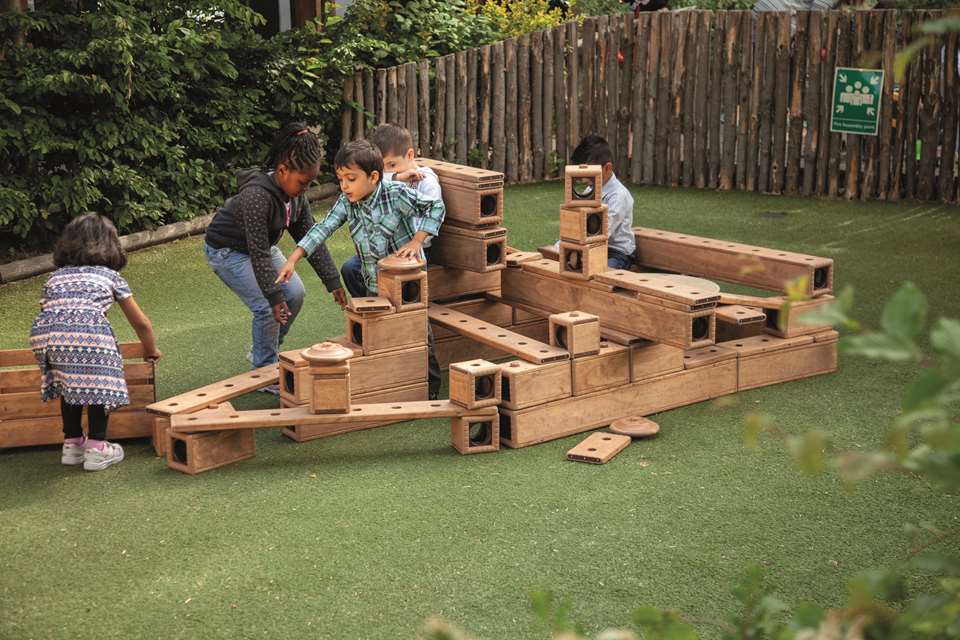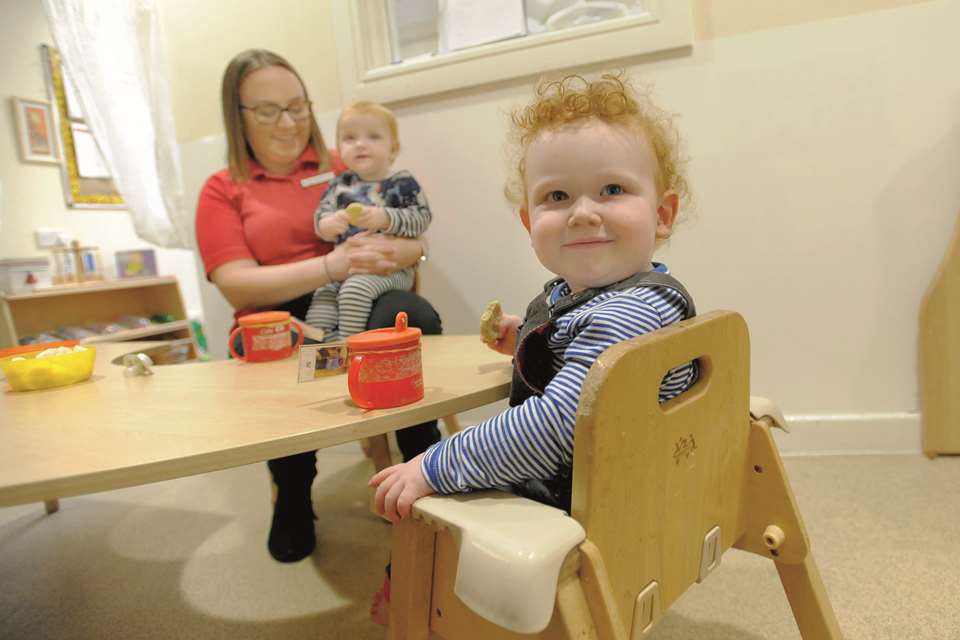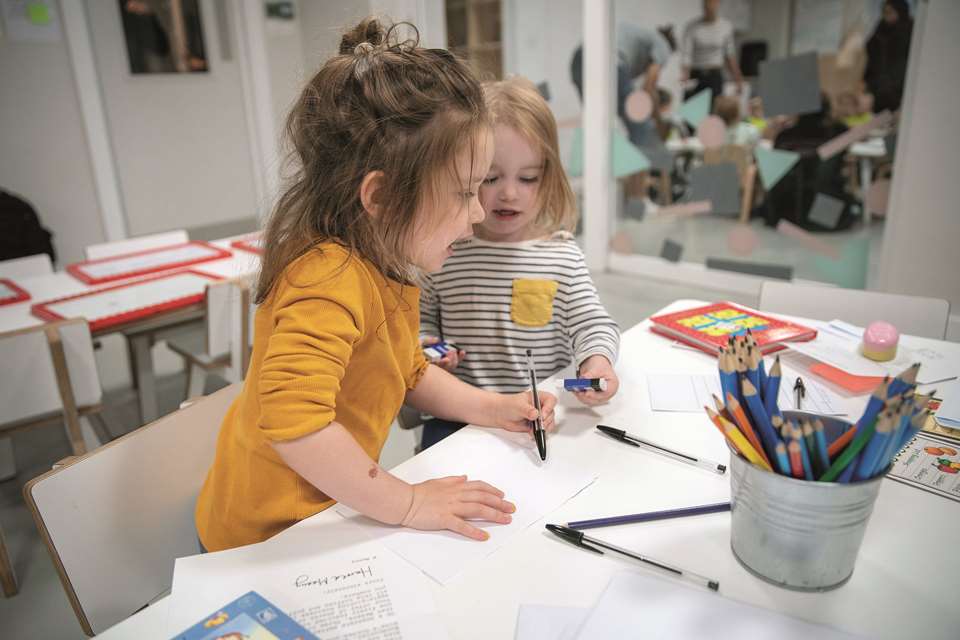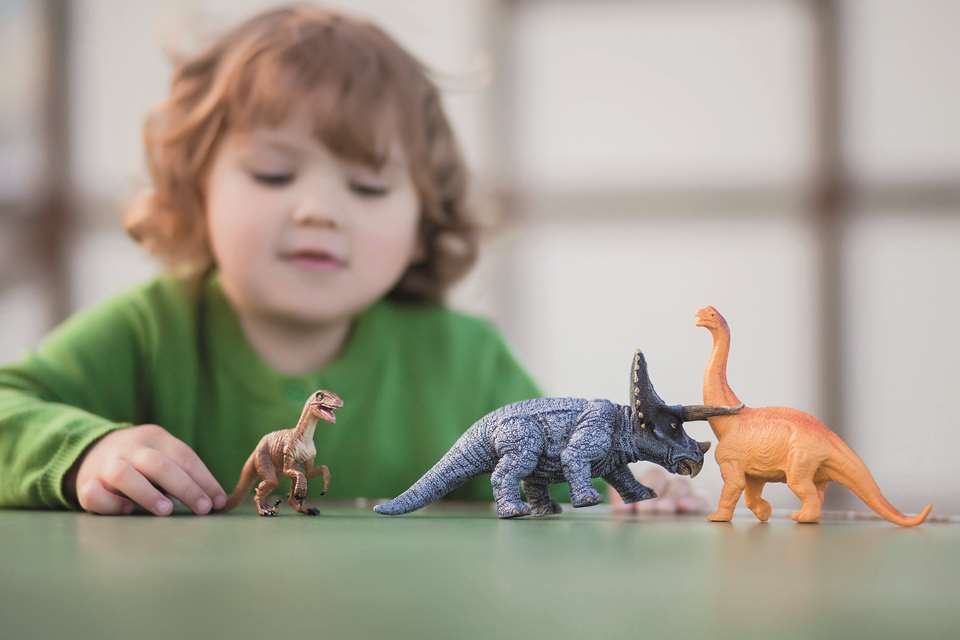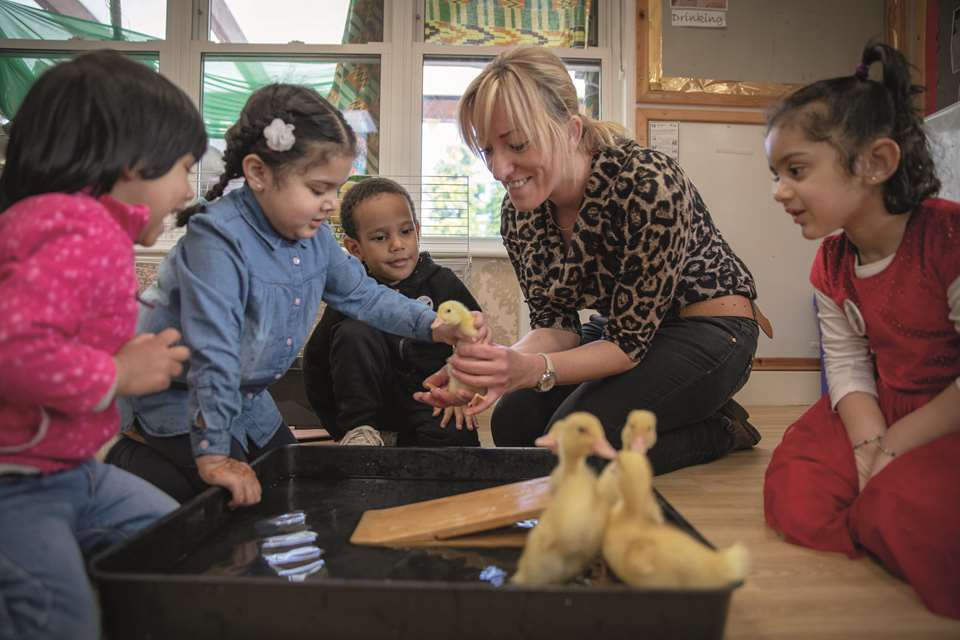Building Your Curriculum: Knowledge, Part 2 – Thinking it over
Professor Elizabeth Wood
Tuesday, June 2, 2020
Thinking and talking about curriculum in early childhood education involves recognising, valuing and building on children’s knowledge, explains Professor Elizabeth Wood
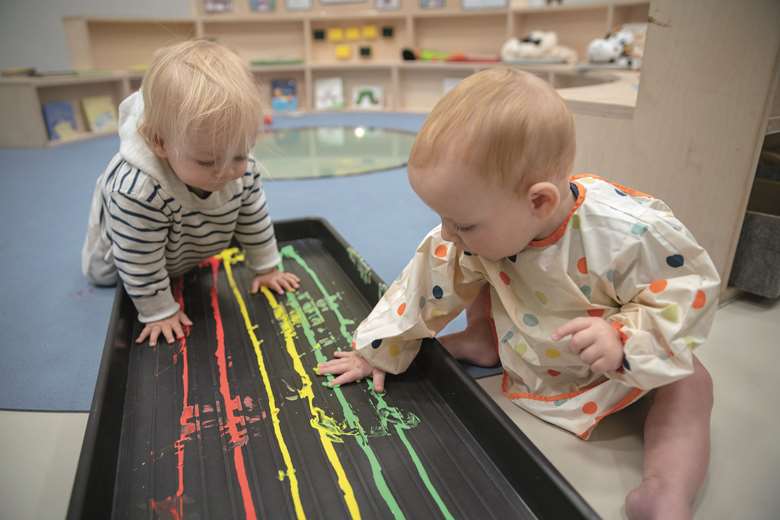
The week my daughter learned to crawl, she made her way into the hall and towards the kitchen. She stopped abruptly at the threshold as her hand touched the unfamiliar vinyl on the kitchen floor, then spent some time repeatedly touching carpet-vinyl, first with one hand, then the other.
This was a moment of deep concentration and focused attention, and she gradually moved both hands, then upper body into the kitchen, each movement followed by a pause, as if checking that the new surface was different in texture but had the same property, as in ‘OK to crawl on’.
I went into the kitchen, knelt in front of her and mirrored her movements. I am not sure if she needed this scaffolding of emotional reassurance, but she moved across the threshold and began the next adventures of exploring another interesting space with any number of new possibilities.
Over many months the forest of chair and table legs became a den, a place to stash toys, and ladders to pull herself to standing. She eventually took her first forays into climbing onto the chairs, followed by standing up at the work surface to help with cooking and washing up.
This seemingly simple story illustrates some fundamental principles about how children learn in multi-modal ways, involving affect, cognition, sensory perceptions and embodiment. These principles should underpin all professional decision-making in early childhood education (ECE) settings, and help us to explore the following questions:
What knowledge, skills and understanding do children bring to a setting?
In what ways can practitioners recognise, value and build on their knowledge?
In my first article, I contested the view that curriculum is ‘what children are taught’ based on the Ofsted framing of curriculum as ‘intent, implementation, impact’. So, let’s now look at research-informed ways of understanding learning that enables us to address the first question, ‘What knowledge, skills and understanding do children bring to a setting?’
THE COMPLEX PROCESS OF LEARNING
The story about my daughter can be interpreted as a typical developmental pathway. But it also illustrates the complex processes of learning and coming to know. First, there is no such thing as being ‘ready to learn’ or ‘being ready for formal learning’. Research tells us that children are active, curious and sociable, and learning is something they are motivated to do every day of their lives.
Learning involves exploratory drives, not just as a means of discovering what is ‘out there’, but finding out what each child is able and willing to do in relationship with people, places, tools and materials and everyday events.
My daughter’s repeated patting of the carpet/vinyl probably included focusing attention, exploring, looking, thinking, sensing, wondering, making decisions and being able and willing to have a go.
Learning is an integrated process involving cognition, emotions, sensory perceptions and embodiment.
Cognitive functions
Psychological theories indicate three cognitive functions that support learning:
- Focused attention.
- Working memory.
- Executive control.
Focused attention
Focused attention can be visual, auditory and sensory, and relates to a child’s ability to concentrate on something (a caregiver’s face, a new toy, the difference between carpet/vinyl). Focused attention can be supported by an adult (including practitioners, family and kinship members) and by assistive technologies, as long as the activity remains close to the child’s interest.
Play and playful activities are particularly helpful for engaging children’s attention because they typically incorporate scope for choice, repetition, imitation, self-determination, variation and positive affect (how emotions influence behaviour).
Focused attention also incorporates the skills of concentrating, staying on task and overcoming distractions – all learning-relevant processes that children generally get better at with experience.
Working memory
Working memory relates to the ability to retain information that can be used or manipulated in the context of new or familiar activities. The information can be small bits, then larger chunks, then coherent conceptual frameworks, which can be open to change and adaptation.
Rehearsal and repetition are useful processes in building working memory and enabling children to develop capacities to use and apply their developing capabilities in different contexts. Again, memory is not just ‘in the head’ but is embodied in all motor functions, so that we can progress from conscious to automatic control, and discard redundant information. For example, once she had processed the carpet/vinyl difference, my daughter ceased to give it any attention because other possibilities took priority.
Executive control
Executive control refers to a range of ‘higher-level’ metacognitive skills such as planning, organising, reflecting and problem-solving. These metacognitive skills also include flexibility in adapting ourselves to different situations – cognitively, socially and emotionally, and adapting things to our needs and interests.
Metacognition also involves being aware of what is involved in learning, knowing what we know, and knowing how to use and apply what we know.
Again, play and playfulness enable children to develop these skills and capabilities, especially through imagination, pretence and symbolic transformations (making one thing stand for something else).
For example, I once observed three- to five-year-old children playing at ‘airports’, which included large blocks laid out for the ‘place where the luggage goes round and round’, a strip of fabric for the runway, a café, a desk to show your tickets and passport and a sniffer dog. The various roles and activities incorporated detailed social and cultural knowledge of travel, holidays and visits to families in different countries.
Ready to learn
Thinking about these theories helps us to understand that children do not become ‘ready to learn’; they are always ready and motivated to learn in the sense of finding out what else there is out there in their social, cultural and material worlds, what they can do, who they are being, and who they might become.
They have cumulative experiences of learning, attending, memorising, exploring, discovering, playing, pretending and imagining. What they are choosing, doing, creating, making, inventing is constantly changing in our rapidly evolving material cultures.
This has been particularly evident during the Covid-19 lockdown when digital technologies have kept children connected, playing, learning, making, tinkering and participating with friends and family. Therefore we can understand curriculum content as emerging from children’s experiences in homes, communities and pre-school settings, based on co-construction and co-creation of knowledge.
BUILDING KNOWLEDGE
I now turn to the second question, ‘In what ways can practitioners recognise, value and build on children’s knowledge and experiences?’ Socio-cultural theories of learning have practical relevance and application in informing practitioners’ professional decision-making in curriculum design, pedagogy and assessment, drawing on multiple sources of curriculum content.
Funds of knowledge
The concept of ‘funds of knowledge’ was originally developed to explain the significance of cultural knowledge that children build in their homes and communities but which may not be consistently valued in education settings.
Funds of knowledge derive from events, family histories, popular culture and the media, and the everyday social and cultural practices in children’s home and community lives (cooking, shopping, hobbies, work, relationships, religious practices, home languages, family interests and activities).
For many children, these practices are multi-generational and reflect diverse kinship and family connections, as exemplified in the following vignette from a study of practitioners’ curriculum decision-making, led by Dr Liz Chesworth and funded by the Froebel Trust.
CASE STUDY: Sesuna
Sesuna (aged three) attends a super-diverse community nursery, with bi- and multi-lingual peers and practitioners. Her parents are from Eritrea and she was born in England. Her parents speak Tigrinya and English to her and her sisters at home. Sesuna speaks both languages but is more fluent in English.
She helps her mother with household activities such as baking and bathing her baby sister. She is observed in the nursery at the water tray, and shows sustained interest in bathing the doll, concentrating intently on the feet. She also likes to add washing-up liquid and create lots of bubbles.
When the researcher talked with Sesuna’s mother, she explained that Sesuna loves to help with bathing the baby, and is allowed to wash her feet. So, Sesuna shows how she brings to the nursery her funds of knowledge of family practices, including caring safely for the baby, using the materials offered.
An interest in baking was shared by many children in the nursery, and was often expressed in their play, revealing different types of bread and bread-making practices common in their homes.
Communities of players
Pre-school settings offer children important opportunities for participating in communities of players, enabling them to put their knowledge and interests to work in dynamic and creative ways. This can include knowledge about play, and being a player. For example:
- Knowing how to connect and build with different types and sizes of construction kits (clicking, snapping, twisting, pushing, pulling, balancing, swiping on a touchscreen).
- Understanding the rules for entering social play, how to contribute to the play, and how to keep the play going (and what happens if you don’t!).
- Co-operating with peers to play a game with rules and understanding ‘winning’ and ‘losing’.
- Using and applying prior knowledge to inform socio-dramatic play (as in the above example of the airport play).
- Knowing how to pretend (playing in role) and communicate symbolically (making one thing stand for something else).
- Remembering and building on play themes.
- Sharing interests.
Children’s interests
The idea of building a curriculum on children’s interests is a familiar mantra in ECE, and the EYFS encourages practitioners to incorporate needs and interests. Practitioners are expected to recognise, respond to and stimulate interests, especially through play, and in ways that might incorporate curriculum goals.
However, research indicates that interests may be interpreted narrowly as activity choices (for example, choosing sand, water, small-world play), and may be seen as temporary as children move across activities. Some interests may be approved and encouraged, and others not, which may reflect practitioners’ values, but could lead to bias and stereotyping.
Existential and everyday
Research indicates that interests are complex, and can include existential as well as everyday matters; for example:
- death-rebirth, death and dying
- good and evil, good/bad, disobedience and punishment
- tools and equipment
- gender – what it means to be a boy/girl
- family roles and relationships
- babies and being a baby, growing up and being a teenager, parent, etc.
- animals and being an animal
- search and rescue
- popular culture (such as blogs, YouTube, films, books, comics)
- myths, legends, Disney, folktales
- power and control – agency, what it means to be a child/adult
- knowledge and coming to know – sources of knowledge.
Children’s interests can be the springboard for questions and deep enquiries, which can be sustained and developed over time, enabling them to build working theories.
Working theories
The New Zealand early childhood framework Te Whāriki pays attention to children’s working theories as learning outcomes. Helen Hedges and her colleagues have further defined this concept.
They propose that working theories represent ‘the tentative, evolving ideas and understandings formulated by children (and adults) as they participate in the life of their families, communities and cultures and engage with others to think, ponder, wonder and make sense of the world in order to participate more effectively within it. Working theories are the result of cognitive enquiry, developed as children theorise about the world and their experiences. They are also the means of further cognitive development, because children are able to use their existing … understandings to create a framework for making sense of new experiences and ideas.’ (Hedges and Jones 2012).
This definition makes connections between interests and funds of knowledge because children seek content knowledge (science, literacy, maths, technology, the creative arts, the humanities) to develop their working theories.
I have always been influenced by the work of Jerome Bruner, first as a practitioner and subsequently as an academic. He argued we should not waste time by delaying the introduction of subject content to young children on the grounds that it is too difficult, because any subject can be taught effectively in some intellectually honest form to any child at any stage of development.
Bruner’s argument reminds us of the importance of content knowledge in the EC curriculum as a means of developing and connecting funds of knowledge, interests and working theories. In her class of four- and five-year-olds, Michelle Hill’s research found working theories that related to:
- human nature: to self-identity; to beliefs, values, religion; to rights and responsibilities; to relationships; to life and death
- the social world: to the structures of human society, families, communities; to organisations in society such as schools and workplaces; to the roles people play in these organisations
- the physical, biological and natural world; to scientific laws and principles; the animal and plant kingdoms.
The children’s enquiries often focused on clarifying understanding, and wanting or needing to know more about these topics to nurture their interests. Their working theories became multiple sources of curriculum content alongside the curriculum framework used in the school.
Enhancing learning
The contemporary theories of learning outlined here provide a sound underpinning for the model of integrated pedagogical approaches provided in Part 1 (Nursery World, May 2020). Based on the research evidence and theories from psychology and education, I also contest the current policy directive on the transition from play to formal learning.
Instead, I propose sustaining continuity in the provision of adult-led and child-initiated activities as a means of enhancing children’s learning capabilities and ensuring they develop the flexibility and creativity to enjoy learning. Sustaining this continuity also supports inclusion and respects diversities in children’s family and home experiences.
Implications for practice
Embracing ‘funds of knowledge’, ‘children’s interests’ and ‘working theories’ has important implications for practitioners’ professional decisions:
- Focused attention, working memory and metacognition are the foundations for effective learning.
- Learning is always multi-modal, and involves affect, cognition, sensory perceptions and embodiment.
- Children’s interests can provide multiple sources of curriculum content.
- Interests can become shared collectively among children with support from practitioners.
- Practitioners can recognise, build on and value children’s knowledge through observing, interacting, listening and noticing what is significant and meaningful for them.
- These pedagogical skills build practitioners’ understanding of the content of children’s enquiries, their possible directions, and their motivations to further learning.
- Working theories can be noted in formative assessments to indicate the direction and content of children’s learning, and enable practitioners to make decisions about next steps.
- Conversations with families enable practitioners to learn about children’s funds of knowledge, including diverse family, kinship and community practices.
SUMMARY: recognising, valuing and building on children’s knowledge
- Learning is an integrated process involving exploratory drives, cognition, emotions, sensory perceptions and embodiment.
- These principles should underpin all decision-making in ECE settings and help practitioners to explore: what knowledge, skills and understanding children bring to a setting, and how to recognise, value and build on this knowledge.
- Learning is supported by three cognitive functions: focused attention, working memory and executive control. These help us to understand that children do not become ‘ready to learn’; they are always ready and motivated to learn about their social, cultural and material worlds, what they can do, who they are being, and who they might become.
- Therefore practitioners can understand curriculum content as emerging from children’s experiences in homes, communities and pre-school settings, based on co-construction and co-creation of knowledge.
- To help them recognise, value and build on children’s knowledge and experiences, practitioners can turn to three aspects of children’s learning: funds of knowledge (the knowledge that children build in their homes and communities), children’s interests, and working theories (children’s evolving understanding as they participate in the life of their families, communities and cultures and engage with others to make sense of the world).
- By embracing these three concepts and sustaining continuity in the provision of adult-led and child-initiated activities, practitioners can develop a practice model that supports inclusion, respects diversities in children’s family and home experiences and enhances all children’s capabilities to learn, and enjoy learning.
MORE INFORMATION
- Hedges H and Jones S (2012) Children’s working theories: The neglected sibling of Te Whāriki’s learning outcomes, Early Childhood Folio, 16(1), 34-39
- Hill M and Wood E (2019) “Dead Forever”: An ethnographic study of young children’s interests, funds of knowledge and working theories in free play, Learning, Culture and Social Interaction, https://doi.org/10.1016/j.lcsi.2019.02.017
- Ministry of Education (1996/2017). Te Whāriki: He whāriki mātauranga mō ngā mokopuna o Aoteraroa. Early childhood curriculum. Learning Media
- www.education.govt.nz/early-childhood/teaching-and-learning/te-whariki
- https://bit.ly/35XEdRm
With thanks to practitioners and children at N London Fields, www.nfamilyclub.com/n-london-fields
Elizabeth Wood is professor of education at the University of Sheffield, and head of the School of Education. Her research interests include play, pedagogy, curriculum and assessment in early childhood education
Download Now

